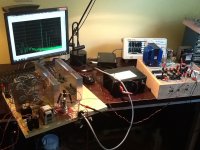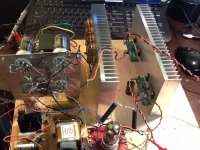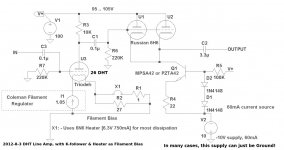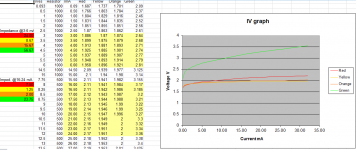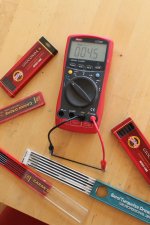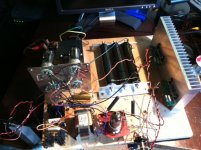I use 100nf with great results, should add the r and try Gary's zobel approach...
Ale
I use 100nF K40-Y9 across my 0A3-0D3 pairs with no issues, in my 26 preamp.
Quad 4P1L in filament bias
Hi all,
This is my try on a quad 4P1L UBT-1 OT, filament bias at 21V, 2.5A/2.1V.
I used 4x33R/50W wirewound chassis mount resistors WH50 on a 10''x5'' radiator from HeatsinkUSA. The sound is so sweet and pure...
I am struggling with a very high temperature of this heatsink. Maybe I should use different resitors in order to reduce the heat impact.
Anybody have experience with this issue?
Thank you,
Radu
Hi all,
This is my try on a quad 4P1L UBT-1 OT, filament bias at 21V, 2.5A/2.1V.
I used 4x33R/50W wirewound chassis mount resistors WH50 on a 10''x5'' radiator from HeatsinkUSA. The sound is so sweet and pure...
I am struggling with a very high temperature of this heatsink. Maybe I should use different resitors in order to reduce the heat impact.
Anybody have experience with this issue?
Thank you,
Radu
Attachments
As you know, I have my 4P1L outputs in 2x PSE with filament bias. I have 10 ohm porcelain resistors at 30W plus 5 ohms in series at 20W for the pair of 4P1L. They're not on a heatsink - just above the chassis. They get hot, but are on 24/7 and no problems. I have 1.2A going through the resistors, plus 60mA. So 15 watts going through the 30W resistor and 8W through the 20W resistor. I did think porcelain resistors sounded better than the aluminium clad ones.
So you are using 4x4P1L outputs? Interesting! Why not - they're cheap and tough. I'm very happy now with my 4P1L > 1660/18mA > 4P1L PSE amp. Just that, no preamp, driven by a HifiMeDIY 23+ SE9023 DAC, lead acid battery PSU. It's mega clean.
I see you are using the LL1692A/18mA. I A-B'd this against the LL1660/18mA and to my ears that was a little better. Not a huge difference, but I did distinctly prefer it.
It's great to see you breaking new ground here!
So you are using 4x4P1L outputs? Interesting! Why not - they're cheap and tough. I'm very happy now with my 4P1L > 1660/18mA > 4P1L PSE amp. Just that, no preamp, driven by a HifiMeDIY 23+ SE9023 DAC, lead acid battery PSU. It's mega clean.
I see you are using the LL1692A/18mA. I A-B'd this against the LL1660/18mA and to my ears that was a little better. Not a huge difference, but I did distinctly prefer it.
It's great to see you breaking new ground here!
Last edited:
Thanks Andy,
I am using the 1692A at 36 mA with 4P1L driver. It works well for my need of only two stages.
My 8.25 ohm equivalent dissipates a little more than 50W. It gets so hot that cannot be touched( prety much same temperature as 4P1L).
I was thinking to have different kind of resistors without a heatsink. They get very hot and need to be away from other components and not reachable by kids or pets .
.
What brand of porcelain are you using? Did you ever try any non-inductive to see the difference in sound?
Am I breaking new ground..? I realy liked the PSe 4P1L because of the half needs of power. The quad demands so much. I used a Hammond 25V 10A for the 2.6A filament bias raw supply and another 252VA Hammomd for the HT supply. I have to built is as monobloc with separate chassis for power supply( monobloc also).
Lots of fun.
I am using the 1692A at 36 mA with 4P1L driver. It works well for my need of only two stages.
My 8.25 ohm equivalent dissipates a little more than 50W. It gets so hot that cannot be touched( prety much same temperature as 4P1L).
I was thinking to have different kind of resistors without a heatsink. They get very hot and need to be away from other components and not reachable by kids or pets
What brand of porcelain are you using? Did you ever try any non-inductive to see the difference in sound?
Am I breaking new ground..? I realy liked the PSe 4P1L because of the half needs of power. The quad demands so much. I used a Hammond 25V 10A for the 2.6A filament bias raw supply and another 252VA Hammomd for the HT supply. I have to built is as monobloc with separate chassis for power supply( monobloc also).
Lots of fun.
I was thinking the same thing, LED center pin bias for the 4P1L, but I went with battery bias instead. It's an interesting idea, I don't remember ever seeing it done with direct heating tubes.Still no bypass cap and even simpler bias solution (heaters can float and LEDs connected to the center tap)?
Anyone try it?
Thanks Andy,
I was thinking to have different kind of resistors without a heatsink. They get very hot and need to be away from other components and not reachable by kids or pets
Yes... those hot resistors. I see your point. Maybe a cage over them? Too hot to go inside. As regards porcelain, or vitreous enamel, you just have to keep searching surplus supplies, ebay etc. They're mostly obsolete but they are about. This is the kind of thing
http://3.bp.blogspot.com/_cQJDlnQI2.../jt_f6WBZTzw/s400/Vitreous+Enamel+Res+DVR.JPG
http://img02.taobaocdn.com/bao/uploaded/i2/56976349/T2jHlcXl0NXXXXXXXX_!!56976349.jpg
Last edited:
I measured some no-name LEDs and found that yellow ones have impedance of only 1.25 Ohm in the 16-24 mA range so with 2 parallel 10-led strings under each output 4P1L that would be only some 6-7 Ohm (12.5 || 12.5) for 20V bias if the tube draws 32 mA - even less than 15R shown in the latest schematic. Still no bypass cap and even simpler bias solution (heaters ca float and LEDs connected to the center tap)?
Hi Dovla,
that is very interesting info! Can you share your measurement setup?
Many thanks, Erik
Did some of you ever try to use the heater of an indirectly heated tube as the power resistor? The quad of 4P1L needs 2,5A/20V, which could heat three 6AS7 (6,3V/@2,5A) in series. That is more tubes on display  , but seriously, these could be used in power supply regulator or a second channel for bi-amplifying, etc.
, but seriously, these could be used in power supply regulator or a second channel for bi-amplifying, etc.
Did some of you ever try to use the heater of an indirectly heated tube as the power resistor? The quad of 4P1L needs 2,5A/20V, which could heat three 6AS7 (6,3V/@2,5A) in series. That is more tubes on display, but seriously, these could be used in power supply regulator or a second channel for bi-amplifying, etc.
hi Erik,
I have recommended this circuit (on the 26-preamp thread) - especially if you want a low-cost (but good quality) solution.
The IDHT can be heated to provide a cathode follower output for a line-stage, (please see the diagram) or the cathode-follower can drive grids of the 4P1Ls into A2, (like Anatoliy does) if you are working on a Power Amp.
Attachments
Thanks Andy,
I am using the 1692A at 36 mA with 4P1L driver. It works well for my need of only two stages.
My 8.25 ohm equivalent dissipates a little more than 50W. It gets so hot that cannot be touched( prety much same temperature as 4P1L).
I was thinking to have different kind of resistors without a heatsink. They get very hot and need to be away from other components and not reachable by kids or pets.
What brand of porcelain are you using? Did you ever try any non-inductive to see the difference in sound?
Am I breaking new ground..? I realy liked the PSe 4P1L because of the half needs of power. The quad demands so much. I used a Hammond 25V 10A for the 2.6A filament bias raw supply and another 252VA Hammomd for the HT supply. I have to built is as monobloc with separate chassis for power supply( monobloc also).
Lots of fun.
Hi Radu, nice work! and yes - Loads of fun.
The Welwyn W24 is a low-cost Vitreous enamelled porcelain resistor, wirewound element.
They are excellent value for money, and low enough in cost that you can parallel them up for lower noise, and high power handling. You need to spend a high price to get better than these.
They are used in professional valve audio from E.A.R. - for those that like to have a celebrity endorsement!
W24 47R JI - WELWYN - RESISTOR, WW 14W 5% 47R | Farnell United Kingdom
Wirewound resistors prepared in Ayrton-Perry style (non-inductive) are a little bit better, especially if you can find NOS - which are usually non-magnetic, too.
.
Hi Dovla,
that is very interesting info! Can you share your measurement setup?
Many thanks, Erik
Just put LEDs and a resistor in series, applied variable DC voltage and measured the drop across the resistor (to calculate current) and across the LEDs. The ranges I was interested in were 1-6 ma (for drivers) and 16-24 (for half the current of an EL84 and similar).
Attachments
10 ohm 100 Watt Ohmite Tubular Power Resistor
This is the kind of thing. They do come in big sizes. Search the site on "ohmite power resistor" for more.
This is the kind of thing. They do come in big sizes. Search the site on "ohmite power resistor" for more.
Last edited:
Anybody tried those?
Peter Avgeris in Athens is using DIY graphite-rod resistors for the current-sense resistor in my Filament Regulators:
http://www.diyaudio.com/forums/tubes-valves/38248-new-dht-heater-9.html#post2913279
Peter is very pleased with the performance.
With filament bias, the sensitivity to quality will be higher still, so it could be worth some experiment.
Bought some giant Ward Leonard 25ohm/100W tubular Vitreous enamel from Talonix.com. Indeed, the sound is better than with the previous resistors(Al clad), Diana Krall sounds more sweet and transparent. And also better solution than having an exposed extra hot heatsink. Just need to placed them above the top plate and be caged. A little paradox over here: want the tubes exposed but the resistors caged...pretty much the same contact temperature...
Attachments
- Home
- Amplifiers
- Tubes / Valves
- One more 4P1L SE
